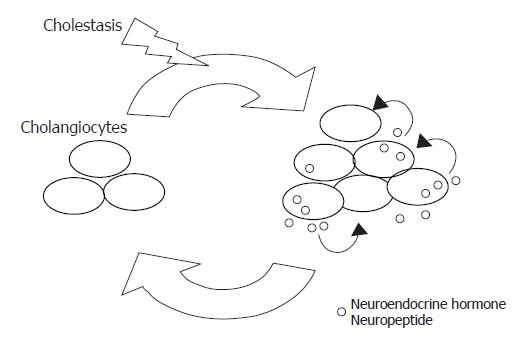Copyright
©2006 Baishideng Publishing Group Co.
World J Gastroenterol. Jun 14, 2006; 12(22): 3471-3480
Published online Jun 14, 2006. doi: 10.3748/wjg.v12.i22.3471
Published online Jun 14, 2006. doi: 10.3748/wjg.v12.i22.3471
Figure 1 Proposed working model for the existence of an autocrine/paracrine loop of neuroendocrine hormones and neuropeptides that regulate the proliferative response of cholangiocytes to cholestasis.
A chronic cholestatic condition induces cholangiocyte proliferation and their transdifferentiation in neuroendocrine-like cell. This allows the biliary epithelium to start to synthesize and secrete a number of peptides that aim to counterbalance the effects of cholestasis itself on cell growth, as a sort of negative feed-back.
- Citation: Marzioni M, Fava G, Benedetti A. Nervous and Neuroendocrine regulation of the pathophysiology of cholestasis and of biliary carcinogenesis. World J Gastroenterol 2006; 12(22): 3471-3480
- URL: https://www.wjgnet.com/1007-9327/full/v12/i22/3471.htm
- DOI: https://dx.doi.org/10.3748/wjg.v12.i22.3471









